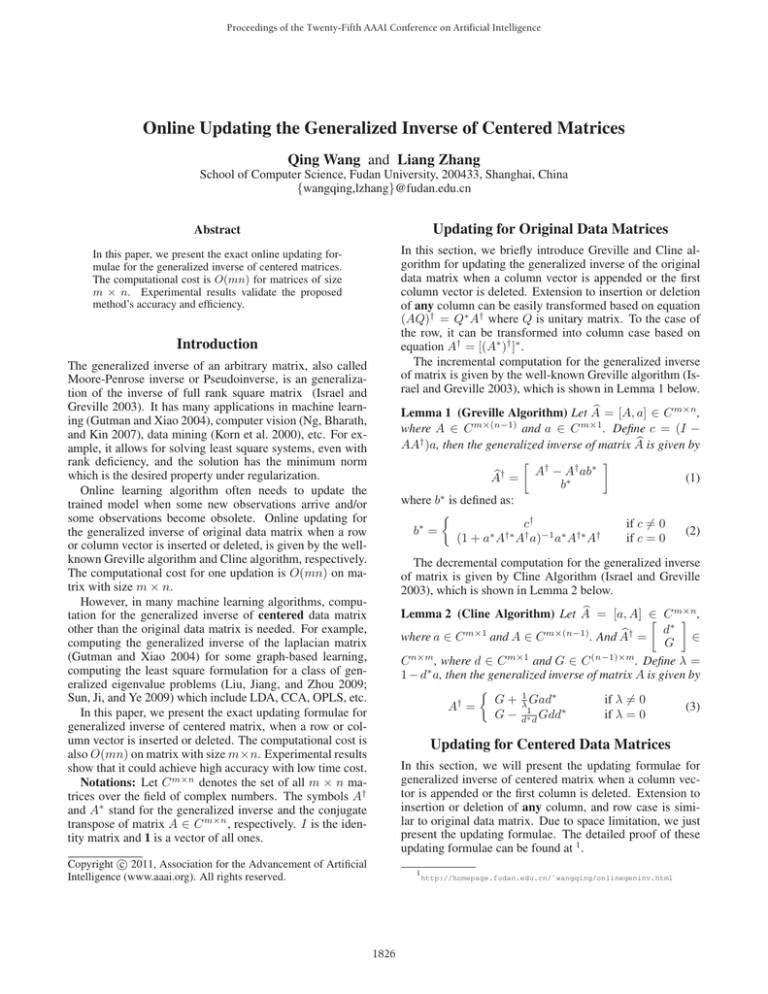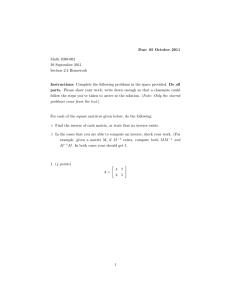
Proceedings of the Twenty-Fifth AAAI Conference on Artificial Intelligence
Online Updating the Generalized Inverse of Centered Matrices
Qing Wang and Liang Zhang
School of Computer Science, Fudan University, 200433, Shanghai, China
{wangqing,lzhang}@fudan.edu.cn
Abstract
Updating for Original Data Matrices
In this paper, we present the exact online updating formulae for the generalized inverse of centered matrices.
The computational cost is O(mn) for matrices of size
m × n. Experimental results validate the proposed
method’s accuracy and efficiency.
In this section, we briefly introduce Greville and Cline algorithm for updating the generalized inverse of the original
data matrix when a column vector is appended or the first
column vector is deleted. Extension to insertion or deletion
of any column can be easily transformed based on equation
(AQ)† = Q∗ A† where Q is unitary matrix. To the case of
the row, it can be transformed into column case based on
equation A† = [(A∗ )† ]∗ .
The incremental computation for the generalized inverse
of matrix is given by the well-known Greville algorithm (Israel and Greville 2003), which is shown in Lemma 1 below.
Introduction
The generalized inverse of an arbitrary matrix, also called
Moore-Penrose inverse or Pseudoinverse, is an generalization of the inverse of full rank square matrix (Israel and
Greville 2003). It has many applications in machine learning (Gutman and Xiao 2004), computer vision (Ng, Bharath,
and Kin 2007), data mining (Korn et al. 2000), etc. For example, it allows for solving least square systems, even with
rank deficiency, and the solution has the minimum norm
which is the desired property under regularization.
Online learning algorithm often needs to update the
trained model when some new observations arrive and/or
some observations become obsolete. Online updating for
the generalized inverse of original data matrix when a row
or column vector is inserted or deleted, is given by the wellknown Greville algorithm and Cline algorithm, respectively.
The computational cost for one updation is O(mn) on matrix with size m × n.
However, in many machine learning algorithms, computation for the generalized inverse of centered data matrix
other than the original data matrix is needed. For example,
computing the generalized inverse of the laplacian matrix
(Gutman and Xiao 2004) for some graph-based learning,
computing the least square formulation for a class of generalized eigenvalue problems (Liu, Jiang, and Zhou 2009;
Sun, Ji, and Ye 2009) which include LDA, CCA, OPLS, etc.
In this paper, we present the exact updating formulae for
generalized inverse of centered matrix, when a row or column vector is inserted or deleted. The computational cost is
also O(mn) on matrix with size m×n. Experimental results
show that it could achieve high accuracy with low time cost.
Notations: Let C m×n denotes the set of all m × n matrices over the field of complex numbers. The symbols A†
and A∗ stand for the generalized inverse and the conjugate
transpose of matrix A ∈ C m×n , respectively. I is the identity matrix and 1 is a vector of all ones.
= [A, a] ∈ C m×n ,
Lemma 1 (Greville Algorithm) Let A
m×(n−1)
m×1
and a ∈ C
. Define c = (I −
where A ∈ C
is given by
AA† )a, then the generalized inverse of matrix A
A† − A† ab∗
†
A =
(1)
b∗
∗
where b is defined as:
if c = 0
c†
b∗ =
(2)
∗ †∗ † −1 ∗ †∗ †
if c = 0
(1 + a A A a) a A A
The decremental computation for the generalized inverse
of matrix is given by Cline Algorithm (Israel and Greville
2003), which is shown in Lemma 2 below.
= [a, A] ∈ C m×n ,
Lemma 2 (Cline Algorithm) Let A
∗ † = d
∈
where a ∈ C m×1 and A ∈ C m×(n−1) . And A
G
C n×m , where d ∈ C m×1 and G ∈ C (n−1)×m . Define λ =
1 − d∗ a, then the generalized inverse of matrix A is given by
if λ = 0
G + λ1 Gad∗
A† =
(3)
G − d∗1d Gdd∗
if λ = 0
Updating for Centered Data Matrices
In this section, we will present the updating formulae for
generalized inverse of centered matrix when a column vector is appended or the first column is deleted. Extension to
insertion or deletion of any column, and row case is similar to original data matrix. Due to space limitation, we just
present the updating formulae. The detailed proof of these
updating formulae can be found at 1 .
c 2011, Association for the Advancement of Artificial
Copyright Intelligence (www.aaai.org). All rights reserved.
1
1826
http://homepage.fudan.edu.cn/˜wangqing/onlinegeninv.html
Method
n
time XX † X − XF X † XX † − X † F (XX † )∗ − XX † F (X † X)∗ − X † XF
SVD method 50 0.0406
3.13E-13
9.02E-16
1.94E-14
1.78E-14
our method
0.0065
5.00E-14
1.86E-16
4.52E-15
1.50E-15
SVD method 100 0.1154
6.04E-13
1.76E-15
3.73E-14
3.46E-14
our method
0.0156
9.01E-14
3.48E-16
9.04E-15
3.89E-15
SVD method 200 0.3697
1.07E-12
3.25E-15
6.65E-14
6.28E-14
our method
0.0343
1.95E-13
7.21E-16
1.74E-14
1.17E-14
SVD method 400 1.5412
1.96E-12
6.78E-15
1.27E-13
1.22E-13
our method
0.0871
4.93E-13
2.15E-15
3.69E-14
4.20E-14
SVD method 800 10.0037
3.43E-12
1.89E-14
2.83E-13
2.60E-13
our method
0.1841
1.86E-12
2.02E-14
9.57E-14
4.21E-13
SVD method 800 9.9716
3.42E-12
1.89E-14
2.83E-13
2.59E-13
our method
0.1571
1.86E-12
2.01E-14
1.07E-13
4.19E-13
SVD method 400 1.5303
1.93E-12
6.69E-15
1.26E-13
1.20E-13
our method
0.0791
1.12E-12
6.10E-15
8.27E-13
9.14E-14
SVD method 200 0.3712
1.06E-12
3.28E-15
6.56E-14
6.22E-14
our method
0.0309
6.69E-13
3.64E-15
7.10E-13
5.16E-14
SVD method 100 0.1139
5.78E-13
1.72E-15
3.67E-14
3.38E-14
our method
0.0147
3.76E-13
1.56E-15
5.42E-13
2.76E-14
SVD method 50 0.0359
3.32E-13
9.33E-16
2.08E-14
1.96E-14
our method
0.0061
2.16E-13
7.71E-16
3.95E-13
1.41E-14
Appending a new column Let A ∈ C m×(n−1) be the the
original data matrix and m ∈ C m×1 be the the column mean
of A. And X ∈ C m×(n−1) be the column centered matrix
of A and X † be the generalized inverse of X. In the updating process, the mean of original data matrix m, the column
centered data matrix X and its generalized inverse X † are
kept and updated during the process.
When a column vector a is appended, the mean m is first
updated according to m
= m+ n1 (a−m). Then the centered
data matrix is updated. After the append of a, X should be
re-centered according to
Figure 1: Computational time and error of SVD and our method
for column centered data matrix when the n-th column is inserted,
then randomly chosen n-th column is deleted inversely.
= [X − 1 (a − m)1∗ , n − 1 (a − m)]
X
(4)
n
n
where 1 denotes the column vector of all ones with size n−1.
† is calculated according to Theorem 3.
Then X
we turn to inversely delete one randomly chosen column in
X each time until X is null . At each step, the accuracy of
algorithms is examined in the error matrices corresponding
to the four properties characterizing the generalized inverse:
XX † X−X, X † XX † −X † , (XX † )∗ −XX † and (X † X)∗ −
X † X. The process is repeated ten times and the averaged
value is reported. Fig. 1 shows the running time (second)
and the four errors of certain steps.
From Fig.1, we can see that the computational error of
our method is lower than 10−12 in all cases and is often very
closed to SVD method. Moreover the computational time of
our method is significantly lower than SVD method, especially when the matrix is large. So, we can conclude that our
method is a robust and efficient tool for online computing
the generalized inverse of centered matrix.
In addition, our method can make the least squares formulation for a class of generalized eigenvalue problems (Sun,
Ji, and Ye 2009) be suitable for online learning, since these
problems require the data matrix to be centered.
X, X † , a and m are defined above. DeTheorem 3 Let X,
fine e = (I − XX † )(a − m), then
†
1
X − X † (a − m)h∗ − n−1
1h∗
†
X =
(5)
h∗
where the h is defined as :
e†
h∗ =
(n−1)(a−m)∗ X †∗ X †
n+(n−1)(a−m)∗ X †∗ X † (a−m)
if e = 0
if e = 0
(6)
m×n
Deleting
,
the
first column Let X = [x, X] ∈ C
∗
l
† =
X
be the column mean of the
∈ C n×m and m
U
When the first column
original matrix corresponding to X.
x is deleted, the mean vector m is first updated according to
1
x. Then the centered data matrix is updated.
m=m
− n−1
should be re-centered according
After the deletion of x, X
to
+ 1 x1∗
(7)
X=X
n−1
Then X † is calculated according to Theorem 4.
Acknowledgements This work was supported in part by
NSFC (60873115) and AHEDUSF (2009SQRZ075).
References
Golub, G. H., and Loan, C. F. V. 1996. Matrix Computations.
Baltimore, MD: The Johns Hopkins University Press, 3rd edition.
Gutman, I., and Xiao, W. 2004. Generalized inverse of the laplacian matrix and some applications. Bulletin de Academie Serbe des
Sciences at des Arts (Cl. Math. Natur.) 129:15–23.
Israel, A. B., and Greville, T. N. E. 2003. Generalized inverses:
Theory and applications. New York, NY: Springer, 2nd edition.
Korn, F.; Labrinidis, A.; Kotidis, Y.; and Faloutsos, C. 2000. Quantifiable data mining using ratio rules. The VLDB Journal 8:254–
266.
Liu, L. P.; Jiang, Y.; and Zhou, Z. H. 2009. Least square incremental linear discriminant analysis. In Proceedings of the 9th
International Conference on Data Mining (ICDM 2009), 298–306.
Ng, J.; Bharath, A.; and Kin, P. 2007. Extrapolative spatial models
for detecting perceptual boundaries in colour images. International
Journal of Computer Vision 73:179–194.
Sun, L.; Ji, S. W.; and Ye, J. 2009. A least squares formulation for
a class of generalized eigenvalue problems in machine learning.
In Proceedings of the 26th International Conference on Machine
Learning (ICML 2009), 1207–1216. Morgan Kaufmann.
Theorem 4 Let X, U , x and l are defined above. Define
n ∗
θ = 1 − n−1
l x, then
n
1
U xl∗ + n−1
1l∗ ) if θ = 0
U + θ1 ( n−1
(8)
X† =
1
∗
U − l∗ l U ll
if θ = 0
Experiments and Conclusions
In this experiment, we compare the accuracy and efficiency
of our method to SVD method (Golub and Loan 1996)
for the computation of generalized inverse of centered matrix. The results are obtained by running the matlab (version R2008a) codes on a PC with Intel Core 2 Duo P8600
2.4G CPU and 2G RAM. We generate synthetic matrix of
size m = 1000 and n = 800 which entry is random number in [−1, 1]. And the rank deficiency is produced by randomly choosing 10% columns be replaced by other random
columns in the matrix.
We start with a matrix X composed of the first column of
the generated matrix A, then sequentially insert each column
of A into X. After all the columns of A are inserted into X,
1827






